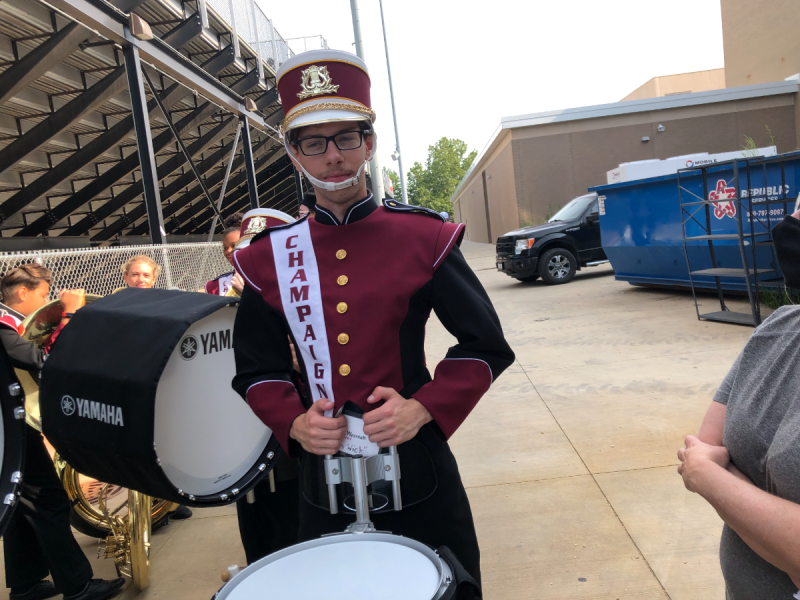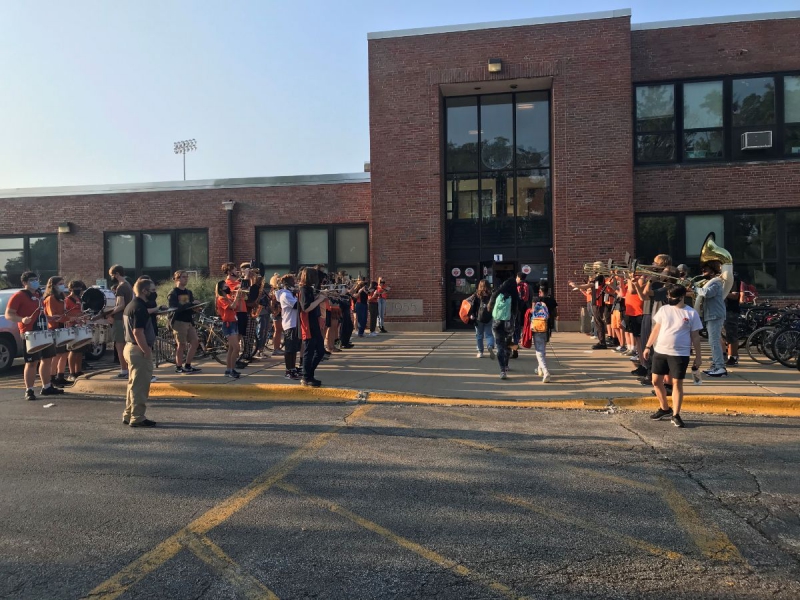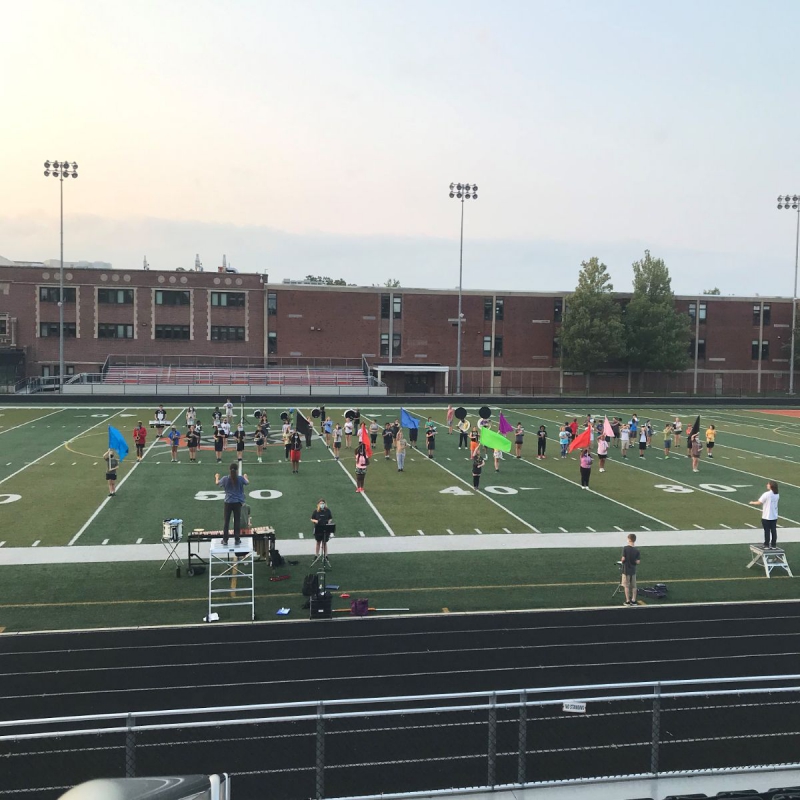The scorching heat of summer is fading into shorter days and, if you’ve been outside recently, you may have heard some familiar sounds carried on the breeze. Students are back in school, football season is just days away, and with it comes the arrival of an extra special season: marching band season.
This month, I asked three people — two brothers on the Central drumline and the director of the Urbana Marching Tigers — to help me share what marching band culture is and what it means to marching musicians and their adoring fans.

Photo by Joanna Wozniak.
John Wozniak is a junior at Central High School, and he plays snare on the Marching Maroons drumline. Theo Wozniak — younger brother of John Wozniak — is a freshman at Central, and he’s beginning his high school marching band career on tenors. When asked what marching band means to him, Theo Wozniak explains that “it’s basically like a big friend group, except we all play instruments together. When you march, you’re hanging out with your friends, but you’re playing instruments.” John Wozniak describes marching similarly, saying how “everyone is super close: it’s basically like a family, ultimately.”

Photo by Stacey Peterik.
On the other side of Wright Street, Ms. Stacey Peterik is the director of the Urbana High School Tiger Marching Band, in addition to her other roles as Fifth Grade Band Director, and Urbana Middle School and Urbana High School Jazz Band Director. She explains that marching band culture “is one where everyone is welcome and we’re all one big family. Our students are all very supportive of each other in every thing that they do, whether in marching band or other activities.”
If you’ve ever been to a local high school or college football game, you’ve surely seen a marching band perform. There’s a one-of-a-kind energy that a battery of musicians taking the streets or taking the field exudes. If you’ve never been in marching band, you might not realize just how powerful the experience is and just how much work goes into a field show or a parade. This hard work is what builds a culture of support, friendship, trust, and high standards.
Most public high schools in our area have a marching band. Some begin rehearsing in late spring and over summer break, then they perform at home football games and compete in competitions in late August through late October. Last year, marching band rehearsals and competitions were canceled or otherwise heavily impacted by pandemic restrictions. For now, it looks like this marching season gets the green light. Peterik explains that, “as of right now, we are moving ahead with football games and competitions as planned. We are all following the safety guidance of our school districts to make sure that we can do this safely.”
That’s welcome news to students who have been gearing up for months. High schools in our area typically welcome everyone who wants to be in the band, either as an instrumentalist or a color guard member. Drumline and color guard might hold auditions or spring sectionals. Older students with at least one marching season under their belt might choose to audition for drum major — high school marching bands in Central Illinois typically choose 2-4 students to wear the drum major uniform, lead the band onto the field at football games and competitions, conduct songs, and do a lot of behind the scenes work to get their band ready to perform. Local schools frequently send their drumline, color guard, section leaders, and drum majors to a summer camp — like the nationally-acclaimed Smith Walbridge Clinics in nearby Charleston, Illinois — to develop their leadership and performance skills so that they’re ready for their school’s band camp. Both John and Theo Wozniak attended this camp with another Central drumline student and other students who want to improve their technique and learn valuable leadership skills.

Photo by Stacey Peterik.
Most band members attend camp all day, every day, for one or two weeks before school starts. At band camp, band members catch up after a long summer’s break, welcome freshmen and other new members, rehearse field show music and stands tunes, and get very sweaty, sunburnt, and dehydrated while learning drill for the field show. Band camp is where sections form close bonds with one another. By the time the first day of school rolls around, marching band members walk confidently into school, already knowing and trusting the scores of students they met just a few weeks before. To make band camp better, many sections and bands have traditions and spirit days. John and Theo Wozniak explained how one of their favorite days during band camp was Section Outfit day: “The whole drumline wore hot pink booty shorts and white shirts.”
Marching band is about moving and playing together as one unit. Band members must glide step together, play together, and breathe together. Heels must hit the ground at the exact same time, and heads must be so still that the feathery plumes on one’s uniform hat only move with the breeze. All of this while remembering exactly where your feet need to land on a football field, not arriving at your spot too early or too late, while playing your instrument with excellent tone and big sound. As if that weren’t challenging enough, marching band members must play field show music entirely from memory.
High school marching band culture in Central Illinois includes competing in day-long Saturday competitions. Call time for these shows can be as early as “dark o’clock,” as band members show up at school, pick up their uniforms from enthusiastic band parent volunteers, load up into a yellow school bus, and drive to the hosting school. One of the biggest competitions of the season is the University of Illinois Marching Band Festival, held in late October. In addition to overall scores, sections are scored for specific items: Color guard members must spin their flags together, drum line must lead the band with tight, steady rhythms, and drum majors need to confidently conduct and lead as one unit. Every performance requires band members to focus and think as one, no matter how hot, rainy, muddy, or windy it might be.
Most, but not all, high schools choose one field show to learn, perfect, and perform at each home football game and competition within a season. Field shows have a theme, like the works of a famous composer, selections from a musical, or new musical compositions that tell a story. Every part of a field show is connected to that theme, from the color guard’s outfits, flags, and choreography to whole band’s drill to the drum major’s conducting style. Central High School’s field show this year is “It’s About Time,” with movements “Tick Tock,” “The Hourglass,” and “Chronos.” Centennial’s field show is “Blueprint,” a timely show that explores themes of construction. Peterik describes Urbana High School’s field show, “Lost.”
The idea of our show is that you awaken having crash landed on an island with no memory of what happened. You must survive by exploring the island, uncovering its dark secrets, and piece together the fragments of your past. This is all while you try to figure out how to escape the island.
Peterik speaks to the benefits of marching band for high school students. “It’s tough to name [all the benefits of marching band]. To name a few: students gain leadership skills, the abilities to work together toward a common goal, to manage time, and build relationships on top of having an outlet for creative performance and so much more. There is also the benefit of all the physical activity. There is a lot of movement in marching band in our shows and when we do parades.”
When asked what advice our marching band students and director have for young people interested in marching band, the Wozniak brothers suggest that students simply pick up an instrument, get really good at it, and carry it around everywhere with them. And band director Peterik says, “I would just say that anyone should feel like they can be a part of marching band. You don’t have to play an instrument to join. Tou can be part of color guard, where you might learn to spin a flag, sabre, or rifle. Or, we can teach you to play an instrument. Marching band is where a lot of lifelong friendships and a lot of great memories are made.”
Marching band builds character that lasts long after one’s band days are over, but in the moment, it’s just a fun, wholesome (well, our parents thought it was wholesome) way to have fun with friends, kiss your crush on the late-night bus ride home, and feel an unparalleled sense of accomplishment when you leave it all on the field and the score reflects the effort you poured in. It turns young musicians into lifelong performers, builders, and leaders who see the value in working towards something much bigger than themselves. These folks always carry a piece of marching band culture with them, which vibrates high when they hear those soft marching band notes lilting on the breeze from a nearby field and marching season prepares to take the field for competition once more.








